Normal flora of the skin Study guides, Class notes & Summaries
Looking for the best study guides, study notes and summaries about Normal flora of the skin? On this page you'll find 1982 study documents about Normal flora of the skin.
Page 3 out of 1.982 results
Sort by
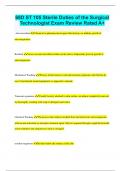
-
68D ST 105 Sterile Duties of the Surgical Technologist Exam Review Rated A+
- Exam (elaborations) • 31 pages • 2024
-
Available in package deal
-
- $10.49
- + learn more
68D ST 105 Sterile Duties of the Surgical Technologist Exam Review Rated A+ Anti-microbial Chemical or pharmaceutical agent that destroys or inhibits growth of microorganisms Residual Leaves an anti-microbial residue on the skin to temporarily prevent growth of microorganisms Mechanical Washing Process which removes soil and transient organisms with friction by use of mechanical means/equipment, as opposed to manual. Transient organisms Usually loosely attached to skin surface, a...
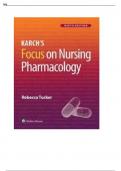
-
Test Bank - Focus on Nursing Pharmacology 9th Edition by Amy Karch Chapter 1-59 | Complete Guide 2023.
- Exam (elaborations) • 985 pages • 2023
-
- $16.89
- 1x sold
- + learn more
. A patient presents at the clinic complaining of vaginal itching and a clear discharge. The patient reports to the nurse that she has been taking an oral antibiotic for 10 days. The nurse is aware that the patient is experiencing what? A) An adverse reaction from the antibiotic B) A drug toxicity effect of the antibiotic C) An overdose of the drug that is damaging to more than one body system D) A superinfection caused by the antibiotic, which has destroyed normal flora Ans: D Feedback:...
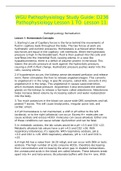
-
WGU Pathophysiology Study Guide: D236 Pathophysiology Lesson 1 TO Lesson 11
- Class notes • 28 pages • 2022
-
Available in package deal
-
- $13.50
- 4x sold
- + learn more
WGU Pathophysiology Study Guide: D236 Pathophysiology Lesson 1 TO Lesson 11 WGU Pathophysiology Study Guide: D236 Pathophysiology Lesson 1 TO Lesson 11: Pathophysiology Remediation Lesson 1: Homeostasis Concepts 1. Starling's Law of Capillary forces is the force behind the movements of fluid in capillary beds throughout the body. The two forces at work are hydrostatic and osmotic pressures. Homeostasis is achieved when these two forces are equal in the capillary- cell interfaces. When...
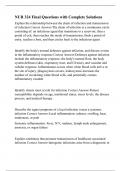
-
NUR 324 Final Questions with Complete Solutions
- Exam (elaborations) • 32 pages • 2024
-
- $14.99
- + learn more
Explain the relationship between the chain of infection and transmission of infection Correct Answer-The chain of infection is a continuous circle consisting of: an infectious agent that transitions to a reservoir, then a portal of exit, then reaches the mode of transmission, finds a portal of entry, reaches a host, and then circles back to the infectious agent Identify the body's normal defenses against infection, and discuss events in the inflammatory response Correct Answer-Defenses again...
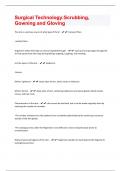
-
Surgical Technology:Scrubbing, Gowning and Gloving Exam All Possible Questions and Answers with complete solution
- Exam (elaborations) • 18 pages • 2023
- Available in package deal
-
- $9.49
- + learn more
The skin is a primary source of what type of flora? --transient flora -resident flora Organisms within the body can also be expelled through: - -nasal and oral passages through the air that passes from the lungs during talking, laughing, coughing, and sneezing. List the layers of the skin: - -Epidermis -Dermis Define: Epidermis - -Outer layer of skin, which varies in thickness Define: Dermis - -Deep layer of skin, containing sebaceous and sweat glands, blood vessels, nerves, and hair roo...

-
NSG-300 Exam 2 (Topics 4-6) with Complete Solutions
- Exam (elaborations) • 23 pages • 2024
-
Available in package deal
-
- $12.99
- + learn more
NSG-300 Exam 2 (Topics 4-6) with Complete SolutionsNSG-300 Exam 2 (Topics 4-6) with Complete SolutionsNSG-300 Exam 2 (Topics 4-6) with Complete Solutions what places patients at risk for pressure ulcers/impaired skin integrity - ANSWER-pressure intensity, pressure duration, tissue tolerance, impaired sensory perception, impaired mobility, alteration in LOC, shear, friction, moisture layers of the skin - ANSWER-epidermis, dermis (collagen) body's defenses against infection - ANSWER-norm...
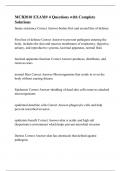
-
MCB2010 EXAM# 4 Questions with Complete Solutions
- Exam (elaborations) • 8 pages • 2024
-
- $16.49
- + learn more
Innate resistance Correct Answer-bodies first and second line of defense First line of defense Correct Answer-to prevent pathogens entering the body, includes the skin and mucous membranes of respiratory, digestive, urinary, and reproductive systems, lacrimal apparatus, normal flora lacrimal apparatus function Correct Answer-produces, distributes, and removes tears normal flora Correct Answer-Microorganisms that reside in or on the body without causing disease Epidermis Correct Answe...

-
EXAM 2024/2025 ONS/ONCC CHEMOTHERAPY IMMUNOTHERAPY CERTIFICATION WITH PRECISE SOLUTIONS
- Exam (elaborations) • 83 pages • 2024
-
- $40.49
- + learn more
The stem cell divides, producing undifferentiated stem cells that are of what lineage? - Precise Answer myeloid or lymphoid What cells do myeloid precursors turn into? - Precise Answer red blood cells, white blood cells, and platelets What cells do lymphoid precursors turn into? - Precise Answer specialized white blood cells called lymphocytes Granulocytes are - Precise Answer basophils, eosinophils, neutrophils Agranuloyctes are - Precise Answer T lymphocytes, B lymphocytes, monocyt...

-
Microbiology CSMLS Review Questions and Answers Rated A+
- Exam (elaborations) • 35 pages • 2024
- Available in package deal
-
- $10.99
- + learn more
Microbiology CSMLS Review Questions and Answers Rated A+ The pulmonary form of anthrax is known as - Valley fever - Walking pneumonia - Farmers' lung - Woolsorters disease Woolsorters disease Streptococci are unable to synthesize the enzyme - Catalase - Kinase - Hyaluronidase - Lipase Catalase (Organisms that synthesize the enzyme catalase are able to protect themselves from the killing effects of H2O2 by converting it to H2O and O2. Streptococci are unable to do this) W...
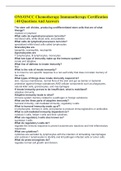
-
ONS/ONCC Chemotherapy Immunotherapy Certification | 40 Questions And Answers
- Exam (elaborations) • 3 pages • 2023
-
- $8.49
- 1x sold
- + learn more
ONS/ONCC Chemotherapy Immunotherapy Certification | 40 Questions And Answers The stem cell divides, producing undifferentiated stem cells that are of what lineage? myeloid or lymphoid What cells do myeloid precursors turn into? red blood cells, white blood cells, and platelets What cells do lymphoid precursors turn into? specialized white blood cells called lymphocytes Granulocytes are basophils, eosinophils, neutrophils Agranuloyctes are T lymphocytes, B lymphocytes, monocytes What...

How much did you already spend on Stuvia? Imagine there are plenty more of you out there paying for study notes, but this time YOU are the seller. Ka-ching! Discover all about earning on Stuvia


